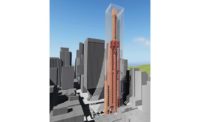Jetter helps develop a revolutionary ropeless elevator

‘VERIZONTAL’ TRAVEL Cabs of the rail-based system, adapted from maglev tech, will travel vertically, horizontally or on an incline.
PHOTO Courtesy TK
Thanks to problems with elevator-cable girth, weight and sway, supertall-building specialists often get hung up on the ropes when designing towers taller than 500 or 600 meters. That’s why ThyssenKrupp Elevator AG is moving full steam ahead to cut the ropes out of supertowers. By 2020, the company expects to offer a long-awaited, cable-free vertical transportation system, with cabs that ride a rail and travel vertically, horizontally or on an incline.
 |
| Markus Jetter |
The system is named Multi because it contains multiple independent cabs in the same shaft—much like a subway tunnel on end. The key is linear drive technology, adapted from magnetic levitation systems used for high-speed rail, which TK also makes. “This is the most revolutionary development in elevators in 160 years,” says Markus Jetter, TK’s head of development. Jetter is leading the Multi team, which has swelled to 50, including 15 TK engineers and various consultants.
Rick Barker, a principal of vertical transportation consultant Barker Mohandes LLC, agrees, saying, “Markus has, in fact, led an R&D effort across the threshold to the untethered Holy Grail of the elevator industry, which will strongly benefit buildings in general.”
The idea of a circulating elevator is more than 100 years old, says Jetter, who has been with TK since 1991, when he earned his degree in electrical engineering. But even as recently as the 1990s, when he saw a TK engineer working on the concept, Jetter was fascinated but incredulous. “I didn’t think it could work,” he says.
The new system will be best suited for buildings taller than 300 m and low-rise buildings with unusual shapes. Multi will cost more up front than a rope-based lift but will generate 50% more handling capacity and reduce elevator footprints by 50%, according to TK.
The ropeless system will give designers more freedom and developers more salable floor area, says Jetter. Cabs will travel at lower speeds than the cabs of many rope systems. But shorter waiting and loading times should result in shorter trip times, he adds. Beyond linear drives, Multi has a new guidance system, new lighter-weight cabs, new redundant safety systems and new traffic-control algorithms.




